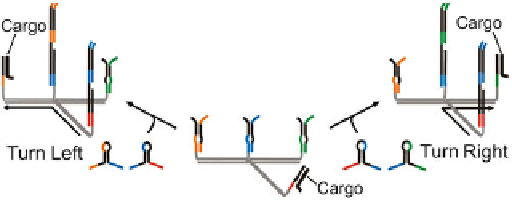Biomedical Engineering Reference
In-Depth Information
Fig. 12.4
Turberfield's DNA motor and track (Reprinted with the permission from Ref [
25
].
Copyright 2011 American Chemical Society)
In 2011, Turberfield and coworkers reported another programmable and au-
tonomous molecular robot which was fueled by DNA hybridization [
25
]. The
system seemed very simple, and it consisted of a road junction like track which
contained several addressable anchorages and a molecular motor that was composed
of a set of strands (Fig.
12.4
). When the fuels with destination information were
introduced to the system, the molecular motor transferred forward the information
bound to a specific anchorage in order to trigger binding to the next anchorage in a
programmed sequence. In contrast to bipedal walkers mentioned above, this motor
was normally bound to the track by a single anchorage and could be programmed
to choose between branches of a track junction while operating autonomously.
The “fuel” hairpins whose hybridization powers the motor also encode the motor's
instructions.
12.3
DNA Walking Devices Based on Origami
In 2006, Rothemund brought the DNA origami with different shapes and high yield
to the field of DNA nanotechnology, which was regarded as a quantum leap for
self-assembly of complex structures. It promoted a rapid development of every
related area. Several exciting developments in molecular robotics have involved
DNA origami platforms. Interestingly, two reports of DNA walkers following
programmed paths on DNA origami were published in the same issue of nature.
Seeman and coworkers reported a system consisting of a triangular DNA walker,
three cassettes inserted in holes of DNA origami platform with controllable arm
and different cargos (gold nanoparticles), and a track also set on the platform
[
20
]. As the walker traverses the pathway on the track, it sequentially encounters
the three DNA devices, each of which can be independently switched between
an “ON” state, allowing its cargo to be transferred to the walker, and an “OFF”
state, in which no transfer occurs (Fig.
12.5
a). This complex system successfully
mimicked an automobile assembly line and exhibited a previously unseen degree of
functional control at the nanoscale. Yan, Stojanovic, Walter, Winfree, and colleagues

Search WWH ::

Custom Search